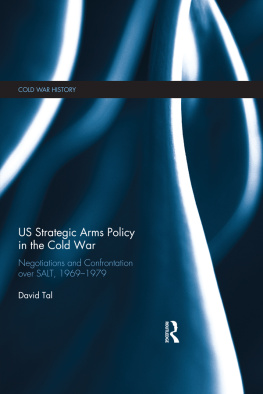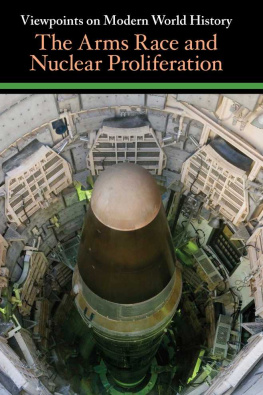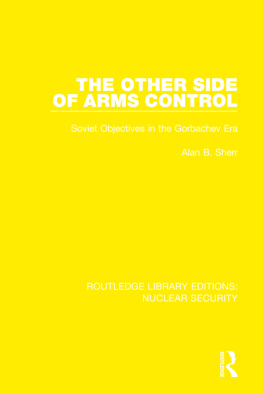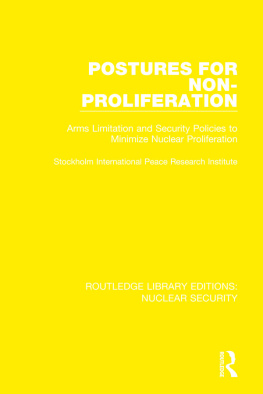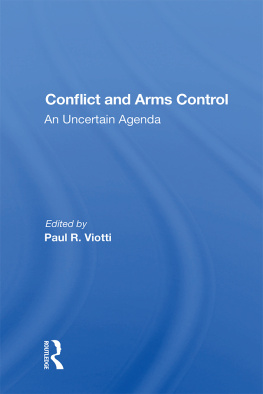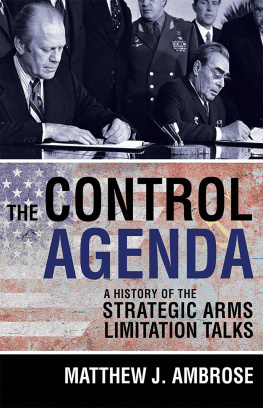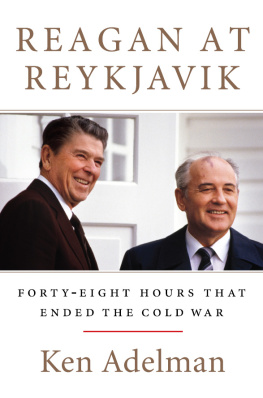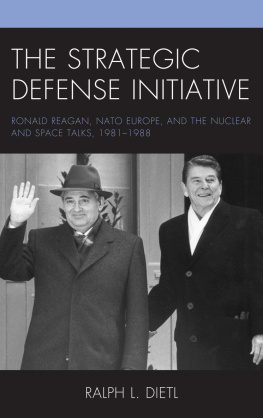US Strategic Arms Policy in the Cold War
This book examines the negotiations between the USA and the USSR on the limitation of strategic arms during the Cold War, from 1969 to 1979.
The negotiations on the limitation of strategic arms, which were concluded in two agreements SALT I and SALT II (with only the first ratified), marked a major change in the history of arms control negotiations. For the first time, in the relatively short history of nuclear weapons and negotiations over nuclear disarmament, the two major nuclear powers had agreed to put limits on the size of their nuclear strategic arms. However, the negotiations between the US and USSR were the easy part of the process. The more difficult part was the negotiations among the Americans. Through the study of a decade of negotiations on the limitation of strategic arms in the Cold War, this book examines the forces that either allowed US presidents and senior officials to pave a path toward a US arms limitation policy, or prevented them from doing so. Most importantly, the book discusses the meaning of these negotiations and agreements on the limitation of strategic arms, and seeks to identify the intention of the negotiators: Were they aiming at making the world a safer place? What was the purpose of the negotiations and agreements within US strategic thinking, both militarily and diplomatically? Were they aimed at improving relations with the Soviet Union, or only at enhancing the strategic balance as one component of the strategic nuclear deterrence between the two powers?
This book will be of much interest to students of Cold War history, arms control, US foreign policy and international relations in general.
David Tal is the Yossi Harel Chair in Modern Israel Studies at the University of Sussex, UK and author of The American Nuclear Disarmament Dilemma, 19451963 (2008) and War in Palestine 1948: Strategy and Diplomacy (Routledge, 2004).
Series: Cold War History
Series Editors: Odd Arne Westad and Michael Cox
In the new history of the Cold War that has been forming since 1989, many of the established truths about the international conflict that shaped the latter half of the twentieth century have come up for revision. The present series is an attempt to make available interpretations and materials that will help further the development of this new history, and it will concentrate in particular on publishing expositions of key historical issues and critical surveys of newly available sources.
Human Rights in Europe during the Cold War
Edited by Kjersti Brathagen, Rasmus Mariager and Karl Molin
NATO and Western Perceptions of the Soviet Bloc
Alliance Analysis and Reporting, 195169
Evanthis Hatzivassiliou
The Cuban Missile Crisis
A Critical Reappraisal
Edited by Len Scott and R. Gerald Hughes
Neutrality and Neutralism in the Global Cold War
Between or Within the Blocs?
Edited by Sandra Bott, Jussi M. Hanhimki, Janick Marina Schaufelbuehl and Marco Wyss
The Trilateral Commission and Global Governance
Informal Elite Diplomacy, 197282
Dino Knudsen
German Reunification
A Multinational History
Edited by Frdric Bozo, Andreas Rdder and Mary Elise Sarotte
Churchill and the Anglo-American Special Relationship
Edited by Alan P. Dobson and Steve Marsh
US Strategic Arms Policy in the Cold War
Negotiations and Confrontation over SALT, 19691979
David Tal
First published 2017
by Routledge
2 Park Square, Milton Park, Abingdon, Oxon OX14 4RN
and by Routledge
711 Third Avenue, New York, NY 10017
Routledge is an imprint of the Taylor & Francis Group, an informa business
2017 David Tal
The right of David Tal to be identified as author of this work has been asserted by him in accordance with sections 77 and 78 of the Copyright, Designs and Patents Act 1988.
All rights reserved. No part of this book may be reprinted or reproduced or utilized in any form or by any electronic, mechanical, or other means, now known or hereafter invented, including photocopying and recording, or in any information storage or retrieval system, without permission in writing from the publishers.
Trademark notice: Product or corporate names may be trademarks or registered trademarks, and are used only for identification and explanation without intent to infringe.
British Library Cataloguing in Publication Data
A catalogue record for this book is available from the British Library
Library of Congress Cataloging in Publication Data
A catalog record for this book has been requested
ISBN: 978-1-138-63264-6 (hbk)
ISBN: 978-1-315-20810-7 (ebk)
Typeset in Bembo
by Wearset Ltd, Boldon, Tyne and Wear
The work on this project has been conducted for several years. During those years I have enjoyed the help and support of various institutions and individuals, to whom I would like to express my thanks. A large part of this project had been carried out during my tenure as a professor at the University of Calgary in Calgary, Canada. The University provided me with an excellent environment for research, both spiritually and materially, and Im deeply grateful to the University authorities, and especially to the staff and my colleagues in the department of history, where I was a member of the faculty for four years (20092013). Im grateful to the Center for Military and Strategic Studies (CMSS) at the University of Calgary and its then director, Dr. David Bercuson, for the financial support for the research. In 2013 I moved to the UK, to the University of Sussex, where I finished writing this book. The University of Sussex was also a great place to research and write and, once again, Im grateful to the university and my colleagues for providing me with such a great working environment.
As is the nature of a work such as this, I spent a lot of time in archives and presidential libraries. I would like to thank the staff of the American national archives, and the presidential libraries of Lyndon Johnson, Richard Nixon, Gerald Ford and Jimmy Carter. In all these places I got a lot of help from librarians and staff who did their utmost helping me to get the material I needed for my work. Especially, I would like to thank Ms. Melissa Lew Heddon, archivist at the Richard Nixon Presidential Library and Museum, for her great help in finding documents and sources which I missed. Im also especially grateful to Ms. Brittany Parris from the Carter Presidential Library, for her great help in filling in what I missed.
The journey ended somewhat abruptly. President Carter signed a second SALT agreement with the General Secretary of the Soviet Communist Party in Vienna, in June 1979. Following that, he negotiated with Congress the ratification of the agreement. The negotiations were not easy, but it looked as if he was making progress. And then, on the night of December 2425, 1979, the Soviet army invaded Afghanistan. Without declaring it at that very moment, it was obvious that the ratification of SALT II would be postponed. As it turned out, it was postponed to oblivion. With that came to an end a journey that had started nearly a decade earlier. The beginning of SALT was also tainted by a Soviet invasion this time, the summer 1968 invasion of Czechoslovakia. President Lyndon Johnson was about to begin negotiations with the Soviet Union over the limitation of strategic arms. The invasion postponed the planned negotiations, but this time, Johnsons successor, Richard Nixon, continued, or had started the negotiations, and managed to bring them to a successful end: he and Leonid Brezhnev signed the SALT I agreement in May 1972, in Moscow. This book tells the story of the negotiations that led to the conclusion of these agreements, and, in the case of SALT II, the process that led to its failure. The need for such a book is the result of the current state of literature that deals with the negotiations on the limitation of strategic arms, which were known as SALT. The literature on this subject is divided into three kinds: first, studies on SALT that were not based on documents. These have been written by academics, journalists and individuals involved in the negotiations, but they did not use archival documents as the basis for their study. In most cases, they also discussed only part of the whole process. Among those we can find John Newhouse, who was a member of SALT I team, who wrote on SALT I; Strobe Talbot wrote on SALT II; and, best known, Raymond Garthoff, who was a member of the SALT I delegation, wrote a major book on dtente, where he dealt extensively with SALT I and II. However, Garthoff, like Newhouse and Talbot, did not use primary sources. That was even truer during the 1970s, when both superpowers further increased the size of their nuclear arsenal. The numbers and the strategic calculations were meaningless. Did it really matter whether each side would have 1,000 nuclear-head ballistic missiles or only 900? Would that make any difference? Furthermore, as is shown throughout the book, the figures and kind of weapons negotiated were not suggested on the basis of well-calculated strategic considerations. The negotiations were based mainly on existing and planned stocks. No strategic or security-based arguments served the negotiators when they discussed certain figures or type of weapons.

